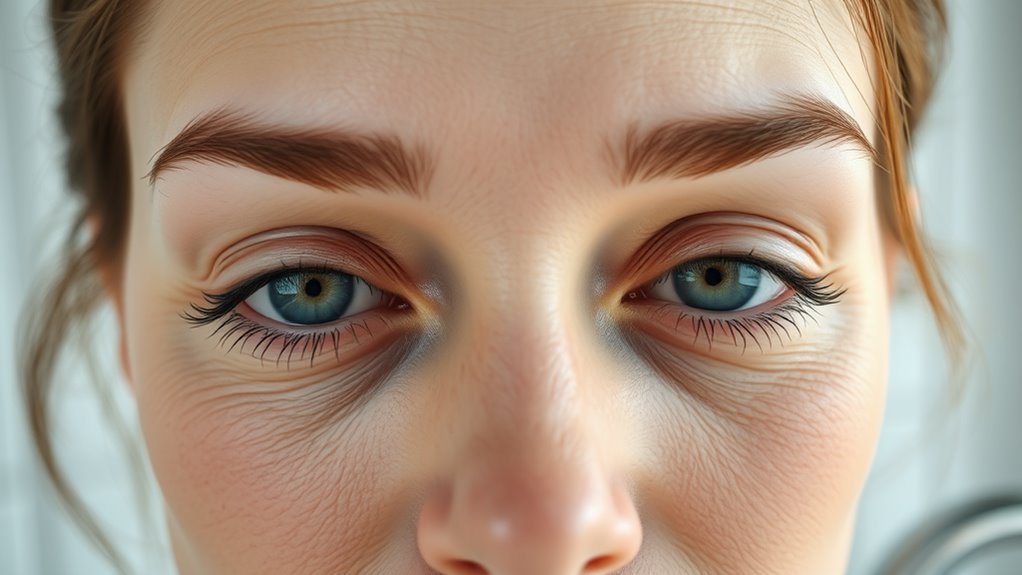Your Eye Bags Might Be From This One Skincare Habit
You might be worsening your eye bags without realizing it by overusing heavy eye creams, which clog pores and disrupt the delicate under-eye barrier, trapping oil and debris that cause inflammation and fluid buildup. This common habit leads to persistent puffiness and hinders natural drainage. Instead, switch to lightweight, non-comedogenic formulas and apply with a gentle tapping motion for better results. Further insights await to help you banish those bags for good.
Key Takeaways
- Overusing heavy eye creams can clog pores and lead to under-eye puffiness by trapping oil and debris.
- Thick moisturizers disrupt the eye area’s delicate barrier, causing inflammation and fluid buildup.
- Applying rich creams excessively traps excess fluid, exacerbating bags under the eyes.
- Switch to lightweight, non-comedogenic formulas to allow skin to breathe and reduce irritation.
- Use a gentle tapping motion when applying eye products to minimize trauma and prevent puffiness.
The Skincare Habit That’s Sabotaging Your Eyes
Although you might think your daily eye cream routine is beneficial, overusing heavy products is sabotaging your eyes by clogging pores and worsening puffiness.
Under eye mistakes, like slathering on thick creams without assessing your skin type, disrupt the delicate barrier around your eyes. You’re essentially trapping oil and debris, which inflames the area and hinders natural drainage.
To fix this, choose lightweight, non-comedogenic formulas that allow your skin to breathe; apply sparingly with clean fingers in a gentle tapping motion.
Scientifically, studies show that excessive occlusion increases transepidermal water loss, exacerbating irritation.
Avoid these errors by reading labels for ingredients like hyaluronic acid, which hydrates without heaviness. Exploring the common causes of puffy eyes can provide deeper insights into prevention.
Remember, less is often more for under eye health, promoting clearer, less swollen skin over time.
Regularly evaluate your routine to prevent these common under eye mistakes from undermining your efforts.
Additionally, addressing persistent eye bags is key to achieving a refreshed and youthful appearance as highlighted in skincare guides.
Common Mistakes Leading to Persistent Puffiness
Persistent puffiness under your eyes often stems from simple yet common mistakes that disrupt your skin’s natural balance.
For example, you overapply rich moisturizers without considering your skin type, trapping excess fluid and exacerbating swelling. You might also use harsh exfoliants or retinol too aggressively, stripping the thin under-eye barrier and triggering inflammation.
Another error is neglecting patch testing new products, which can introduce allergens that provoke persistent edema.
To correct this, always opt for gentle, hypoallergenic formulas and apply them with light, tapping motions to minimize trauma.
Remember, consistency in avoiding these pitfalls helps restore equilibrium, preventing long-term damage.
Moreover, ingredient sensitivities can further irritate the delicate under-eye area, leading to increased puffiness.
Additionally, to maintain skin health and comfort, it’s essential to avoid five critical actions that can aggravate sensitive skin conditions.
How Daily Routines Exacerbate Under-Eye Bags
Your daily routines often worsen under-eye bags by disrupting fluid balance and skin health. When you skimp on sleep, your body’s circadian rhythms falter, causing fluid to accumulate under the eyes.
Excessive salt intake draws water into tissues, amplifying puffiness and inflammation. Prolonged screen time strains delicate eye muscles, reducing blood flow and hindering lymphatic drainage.
If you’re a habitual smoker, toxins damage collagen, thinning the skin and making bags more visible. High-stress lifestyles elevate cortisol levels, which break down elastin and promote water retention. Incorporating stress reduction strategies can also help lower cortisol and support overall skin resilience.
To mitigate this, prioritize balanced hydration; drink water consistently to maintain fluid equilibrium. Remember, inconsistent exercise routines weaken circulation, allowing toxins to build up and exacerbate the issue.
Adopting mindful habits now protects your skin’s integrity long-term.
Additionally, exploring effective treatment options can help address dark circles and puffy eyes for long-term relief.
Identifying Triggers in Your Beauty Regimen
As you review your beauty regimen, specific ingredients like alcohol-based toners or fragranced creams can irritate the thin under-eye skin, leading to inflammation and fluid buildup.
You must scrutinize product labels for common culprits, such as sulfates or parabens, which strip natural oils and compromise the skin’s barrier.
Harsh exfoliants or overly astringent cleansers often trigger reactions, causing capillary dilation that accentuates puffiness.
Track your routine by noting when eye bags worsen after application; this helps pinpoint allergens or irritants.
Conduct patch tests on your forearm before under-eye use to observe redness or swelling. By avoiding these common errors, you can promote healthier skin.
Remember, environmental factors like pollution can amplify these effects, so assess how your products interact with daily exposures.
To enhance your routine and achieve lasting results, consider implementing the crucial tip of avoiding common skincare pitfalls as shared in expert advice.
Simple Adjustments for Brighter Under-Eyes
To brighten under-eye areas effectively, you’ll want to incorporate targeted adjustments that minimize puffiness and enhance circulation.
Start with a daily cold compress—use a chilled spoon or gel mask for 5-10 minutes to constrict blood vessels and reduce fluid buildup.
Next, adopt a gentle lymphatic drainage massage: lightly tap from the inner eye corner outward using your ring finger, promoting better blood flow without irritation.
Ensure adequate sleep—aim for 7-9 hours nightly—to allow natural repair processes.
Hydrate well, drinking at least 8 glasses of water daily, as dehydration exacerbates puffiness.
Adjust your pillow height to elevate your head, preventing fluid accumulation overnight.
These evidence-based tweaks, when consistent, yield noticeable improvements in under-eye brightness and vitality.
Additionally, consider using a dermatologist-recommended eye cream to further support your under-eye health based on expert advice.
For comprehensive results, explore additional remedies for dark circles to complement these adjustments.
Always patch-test new methods for sensitivity.
Ingredients to Watch Out for in Eye Products
When choosing eye products, steer clear of potential irritants like fragrances and alcohol, as these can disrupt the delicate skin barrier and trigger inflammation.
You should also watch for sulfates, which strip essential oils from your skin, causing dryness and exacerbating puffiness.
Parabens and formaldehyde-releasing preservatives act as allergens, potentially worsening under-eye sensitivity by promoting oxidative stress.
Essential oils, often added for scent, can irritate sensitive areas, leading to redness and barrier breakdown.
Always check labels for these culprits; instead, seek products labeled as non-comedogenic and free from common irritants. In contrast, for those with acne-prone skin, incorporating essential ingredients can help treat and prevent breakouts while supporting overall skin health.
This approach helps maintain your skin’s integrity, reducing the risk of chronic inflammation that contributes to eye bags.
To further alleviate redness and sensitivity, consider incorporating soothing strategies from expert advice to achieve a calm, balanced complexion.
Effective Techniques to Soothe Swollen Areas
Effective techniques can swiftly reduce swelling around your eyes, starting with simple, evidence-based methods like applying a cold compress to constrict blood vessels and minimize inflammation.
You can enhance this by using chilled cucumber slices, which deliver antioxidants to calm irritated skin and reduce puffiness.
For added relief, gently massage the under-eye area with clean fingers in circular motions; this stimulates lymphatic drainage and eases fluid buildup.
Experts recommend elevating your head while sleeping to discourage fluid retention overnight.
Opt for eye creams with caffeine or witch hazel, as research confirms their anti-inflammatory effects.
Always use these methods moderately to avoid overuse, ensuring your skin stays healthy and responsive.
Track improvements to adjust your routine effectively. To optimize your overall skincare, be sure to steer clear of morning skincare mistakes that could undermine your efforts.
By integrating these approaches with additional remedies from reliable sources, you can help brighten your eyes and maintain a refreshed, youthful appearance.
Building a Habit-Free Skincare Approach
You avoid routine habits that can exacerbate eye bags by adopting a flexible skincare strategy.
Simplify your basics to include only essential steps like gentle cleansing and hydration.
This practical approach empowers you to maintain effective eye care without unnecessary rigidity.
Avoid Routine Habits
While routines offer structure, avoiding them in your skincare regimen promotes a flexible approach that adapts to daily changes, particularly for managing eye bags. You prevent overuse of products, which can irritate delicate under-eye skin and exacerbate puffiness.
Instead, assess your skin’s needs daily; for instance, apply lighter hydration on oilier days to reduce fluid retention. Research shows that rigid habits, like nightly heavy creams, often lead to dependency and inflammation, worsening bags.
Actively rotate ingredients—switch between caffeine for de-puffing and peptides for firmness—to maintain efficacy without buildup. Monitor responses closely; if bags persist, tweak applications based on sleep and stress levels.
This method fosters resilience, ensuring your skin stays balanced and responsive, ultimately minimizing those unwanted shadows.
Simplify Skincare Basics
Simplifying skincare basics lets you craft an adaptable regimen that focuses on essentials, like gentle cleansing and targeted hydration, without locking into rigid habits.
This approach minimizes irritation and prevents overuse, which can contribute to eye bags by stressing delicate under-eye skin. You’re in control, adapting to your skin’s needs based on science-backed principles.
-
Prioritize gentle cleansing: Use a mild, pH-balanced cleanser to remove impurities without stripping natural oils, reducing inflammation around the eyes.
-
Target hydration effectively: Apply lightweight, non-comedogenic moisturizers with hyaluronic acid to maintain barrier function and combat puffiness.
-
Monitor and adjust routinely: Observe your skin’s response weekly, tweaking products to avoid buildup or sensitivity, ensuring long-term eye health.
Long-Term Tips for a Refreshed Appearance
To sustain a refreshed appearance and minimize eye bags, adopt habits like daily sunscreen use and consistent hydration, which build resilience against environmental stressors.
You protect your skin by incorporating antioxidant-rich serums into your routine, shielding delicate under-eye areas from free radicals.
Prioritize seven to nine hours of sleep nightly, as this supports cellular repair and reduces puffiness.
Maintain a nutrient-dense diet with vitamins C and E, enhancing collagen production for firmer skin.
Regularly apply gentle eye creams containing caffeine or peptides to improve circulation and elasticity.
Avoid smoking and limit alcohol, as they accelerate aging and fluid retention.
Track progress with monthly skin assessments, adjusting habits based on results for sustained vitality.
Consult a dermatologist for personalized advice to optimize long-term outcomes.

